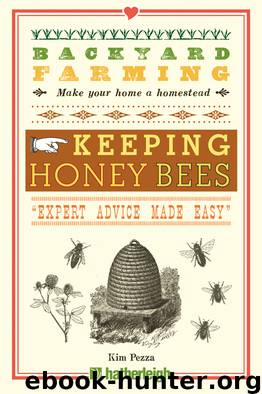Keeping Honey Bees: From Hive Management to Honey Harvesting and More by Kim Pezza

Author:Kim Pezza [Pezza, Kim]
Language: eng
Format: epub, pdf
ISBN: 978-1-57826-453-7
Publisher: Hatherleigh Press
Published: 2013-08-26T16:00:00+00:00
Types of Honey
There are many types of honey, and the type of honey you get depends on where your bees are getting their nectar from. In other words, if the bees feed on orange blossoms, you would have orange-blossom honey. If they are around clover fields, you get clover honey. If they feed from buckwheat fields, they will produce buckwheat honey, and so on. Wildflower honey would be honey made from various wildflower sources. In some honeys, these nectars and flavors may be blended as well. The color of the honey ranges from very light to very dark, with the flavor also depending on the nectar source.
Many consumers will ask if the honey is organic. While some areas do certify that their honey is organic, it is not the norm for the industry. It is very difficult to be sure that the honey that the bees produce is organic, for the simple reason that you do not know for sure where your bees have sourced their nectar and pollen. Even though you may have your hives in an organic orchard, for example, what if a few bees ventured away from the orchard to a neighbor’s fruit tree in his yard? Or another orchard a mile away, which may or may not be organic itself? As a result, few organic-certification organizations will certify honey as organic.
As a consumer, there are a few different ways that you can purchase honey. There is liquid honey, which is the most common form of honey there is. Liquid honey is what you normally see for sale in jars or little squeeze bears. Then there is granulated or crystallized honey, which has a sugary look to it. Creamed honey is liquid honey with finely crystallized honey added to it, while cut-comb honey is pieces of honey-filled comb, usually cut and sold in squares and, occasionally, rounded shapes. Finally, there is chunk honey, which is simply chunks of comb in a container of honey.
Many commercial honeys found in grocery stores have had the pollen filtered out. That leaves only the nectar, and although it is all natural from the honeybee, it is not considered real honey. Also note that, unless your store-bought honey says 100-percent organic, raw, or natural, you risk having corn syrup or high-fructose corn syrup mixed in. (In fact, imported Chinese honey can be up to 40 percent corn syrup.)
Download
Keeping Honey Bees: From Hive Management to Honey Harvesting and More by Kim Pezza.pdf
This site does not store any files on its server. We only index and link to content provided by other sites. Please contact the content providers to delete copyright contents if any and email us, we'll remove relevant links or contents immediately.
The Lonely City by Olivia Laing(4730)
Animal Frequency by Melissa Alvarez(4382)
All Creatures Great and Small by James Herriot(4211)
Walking by Henry David Thoreau(3875)
Exit West by Mohsin Hamid(3763)
Origin Story: A Big History of Everything by David Christian(3631)
COSMOS by Carl Sagan(3536)
How to Read Water: Clues and Patterns from Puddles to the Sea (Natural Navigation) by Tristan Gooley(3384)
Hedgerow by John Wright(3258)
The Inner Life of Animals by Peter Wohlleben(3246)
How to Read Nature by Tristan Gooley(3229)
How to Do Nothing by Jenny Odell(3218)
Project Animal Farm: An Accidental Journey into the Secret World of Farming and the Truth About Our Food by Sonia Faruqi(3163)
Origin Story by David Christian(3132)
Water by Ian Miller(3110)
A Forest Journey by John Perlin(3018)
The Plant Messiah by Carlos Magdalena(2868)
A Wilder Time by William E. Glassley(2804)
Forests: A Very Short Introduction by Jaboury Ghazoul(2777)
